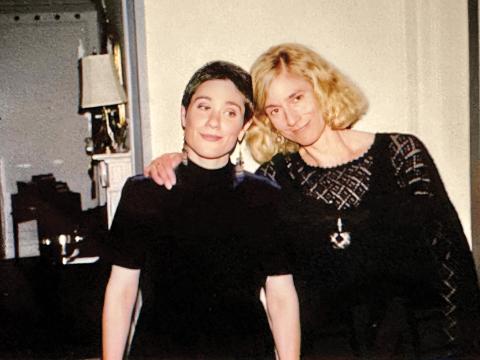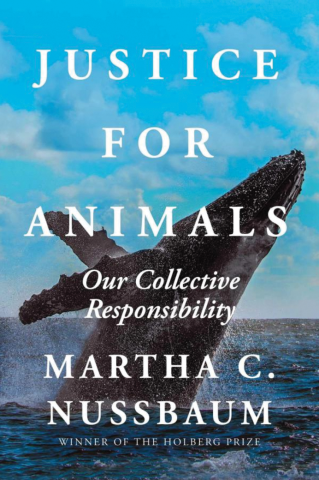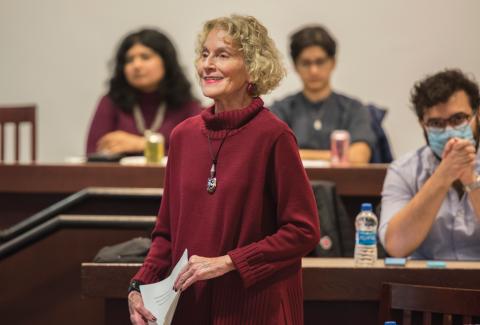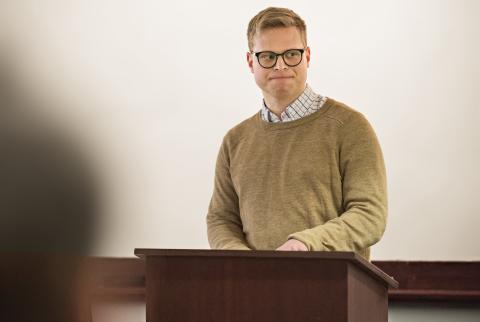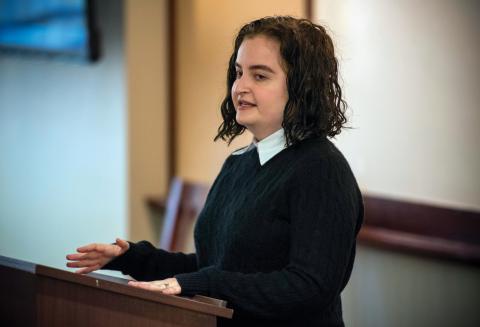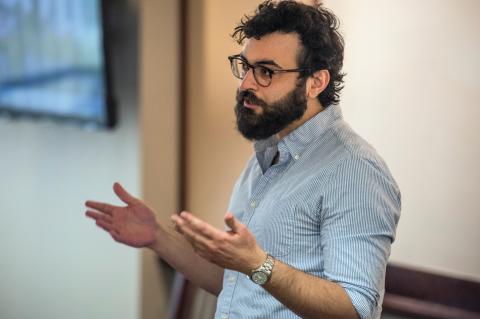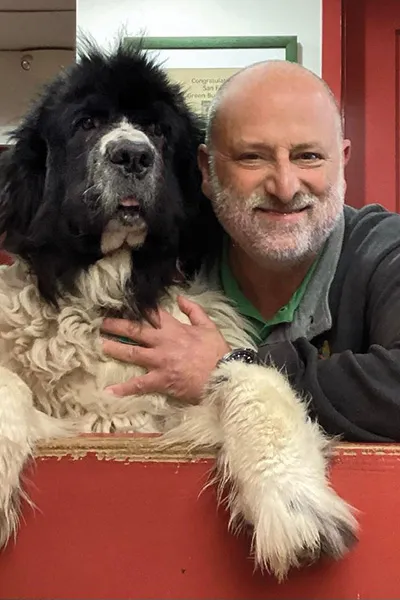‘So Deeply Our Hearts Were Allied’
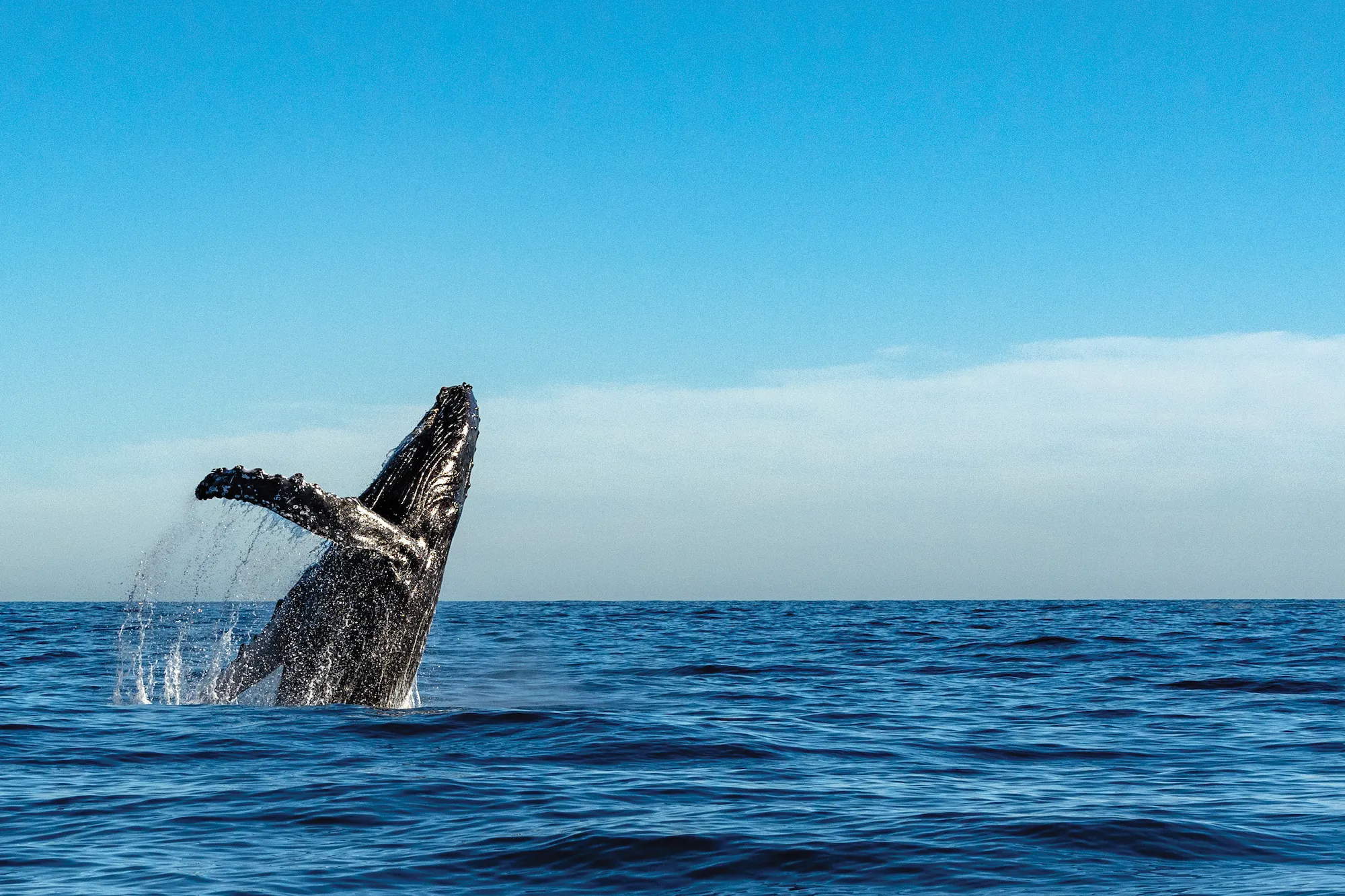
When Martha C. Nussbaum, the prolific author of nearly three dozen books and one of the world’s leading philosophers, faced the most challenging moment of her life—the loss of her beloved daughter—her path forward was clear: she would write.
“What you have to do is find a way of living with that grief and retaining the love and its form will change. So now part of it takes the form, actually, of this book,” said Nussbaum, the Ernst Freund Distinguished Service Professor of Law and Ethics appointed in the Law School and the Philosophy Department, gesturing to a cover featuring a gorgeous whale breaching against a stark blue background.
What sets Nussbaum apart from other authors who faced loss is that, unlike Joan Didion, C. S. Lewis and so many others, her newest book, released in January, is not an introspective look at loss. But like those before her, it seeks to keep a legacy alive—in this case, the work and passions of her late daughter, Rachel.
Justice for Animals: Our Collective Responsibility (Simon & Schuster) is quintessentially both Nussbaum and the University of Chicago. Fully in philosopher mode, Nussbaum deploys the capabilities approach for which she is renowned on behalf of nonhuman animals, making the case for legal protections for everything from pigs and chickens to Rachel Nussbaum Wichert’s beloved whales and Nussbaum’s adored elephants. In classic University of Chicago form, Nussbaum respectfully but forcefully offers alternate theories, pushing the conversation forward onto new, and sometimes controversial, ground.
Nussbaum’s proposed theory for animal rights is an extension of the capabilities approach she has been writing about for nearly half a century. The book explains how this perspective makes it logical to extend legal rights to a huge swath of animals including factory-farmed chickens, pigs, and cows; dogs and cats that live with humans; wild animals affected by human existence.
“Essentially, then, the CA is about giving striving creatures a chance to flourish,” Nussbaum wrote.
Justice, she argues, entitles animals with a set of species-appropriate “capabilities.” These are not inner skills, but opportunities: spaces to choose a form of action that the animal values—for instance, elephants having the opportunity to socialize with their herd and to search for food without being killed for their ivory. She builds her argument in the careful, nuanced style for which she is known: beginning with an examination of justice, exploring theories that fall short of full respect for nonhuman animal lives (including an approach that compares animals to humans), and then laying out her own theory. She closes with chapters on the goals of human-animal friendships and an exploration of existing animal justice laws and their flaws.
“Professor Nussbaum’s book, her ideas about justice for animals, are so in keeping with our highest aspirations at University of Chicago, both here in the Law School and across the entire campus,” said Dean Thomas J. Miles, the Clifton R. Musser Professor of Law and Economics. “Our mission at the University is to expand the boundaries of knowledge and deepen our understanding about the most important questions in our world.”
At the Law School, Nussbaum is taking the desire to honor Wichert’s passion for animal rights even further, establishing the Rachel Nussbaum Animal Law Scholarship to provide support for students who intend to pursue careers in animal law or policy or those who have a demonstrated history of interest in or advocacy on behalf of animals. Also, Nussbaum pledged to use prize money she won for the Balzan Prize for Moral Philosophy in 2022 to call for papers on this topic. Nussbaum will work with the young scholars to hone their writings, which will eventually be published by Oxford University Press.
Spencer Caro, ’23, who is the recipient of another scholarship endowed by Nussbaum, the Ernst Freund Prize, predicted that the Rachel Nussbaum Animal Law Scholarship and the call for papers will give students the chance to deepen their learning by conducting sustained research on an academic question, but also to contribute meaningfully to thought on the subject by publishing their work.
“I think the scholarship is very exciting,” said Caro, who has studied the philosophy of credit scoring with his grant. “I think it is a good representation of what goes on in Martha’s classes because she’s deep in the abstract details of philosophy, but she never loses sight of what it means to the real world.”
Mother, Daughter, and Shared Passion for Animals
Ironically, Wichert, who inspired all of this, was not always a fan of animals.
When she was tiny, the Nussbaums lived in a triple-decker house in Cambridge, Massachusetts, while both her parents finished PhDs and then taught at Harvard University. Also living in the building was Bobby Kennedy Jr., who, Martha Nussbaum recalls, had an Irish setter puppy he kept chained up on the back porch. One day the puppy jumped on little Rachel, knocking her off the porch into a pile of broken glass.
“It was a pretty serious thing. And she therefore had a fear of dogs,” said Nussbaum.
In adulthood, however, after Wichert and her husband Gerd moved to Seattle, she became enchanted by marine mammals, enjoying many whale watching expeditions.
“I think orcas were her great favorite because she thought they were so interestingly complex … Orcas and humans are the only two animals that have menopause. She thought that was cool,” recalled Nussbaum. “The role of these postmenopausal females is apparently to be the agents of social learning. That’s the current theory. So she loved all that.”
Wichert’s first career was in academia. She earned a PhD in German intellectual and cultural history. But as her passion for animals grew, she decided to attend law school at the University of Washington, which has robust offerings in animal law, coastal law, and law of the sea. After graduation she worked as a government affairs attorney in the Wildlife Law Program at Friends of Animals, an international non-profit animal advocacy organization near Denver, Colorado.
“She was singularly focused on animals and animal law, which isn’t something that you come across very often,” said Michael Harris, who was Wichert’s boss there and is now director of the environmental advocacy clinic and an associate professor of law at Vermont Law and Graduate School. “In fact, most of our candidates were more interested in environmental law issues, and animals sort of tag along. But Rachel—that was her passion from moment one. That’s what captured our attention.”
Nussbaum, by contrast, always had an affinity for animals. As a child growing up outside of Philadelphia, she successfully lobbied her parents for a dog, and a white Scottie named Laird became a great friend. Enamored with the Babar books and further inspired on many trips to India, she began collecting model elephants, and they now fill her office at the Law School.
Nussbaum touched on animals even in much earlier work. In 2001, she published Upheavals of Thought: The Intelligence of Emotions, which includes a chapter about animal emotions. And her 2006 book,
Frontiers of Justice: Disability, Nationality, Species Membership, included a chapter on how the capabilities approach, which focuses on the capability of beings to achieve goals of value to them, could be used for animals.
But Wichert’s passion pushed Nussbaum further.
“As long as I live I will see the sparkle in her green eyes and her subversive smile,” wrote Nussbaum in the book’s introduction. “We were a study in contrasts, I with curly blond hair, she with a black almost-buzz cut. I with femmy colorful dresses, she with all-black pantsuits; but so deeply our hearts were allied.”
That alliance—and Martha Nussbaum’s focus on the rights of animals—grew during the final years of Wichert’s life. Harris became friends with Nussbaum on her regular visits to Denver to see Wichert. The two women and Gerd regularly attended Denver Nuggets basketball games and Colorado Rockies baseball games with Harris and often spoke about animal rights as they enjoyed the sports. Having this team of women who could help them marry theory with legal practice had an impact on how the people at Friends of Animals thought about their work.
“Prior to meeting Martha and even Rachel, we had developed this idea of using existing environmental laws to encourage a broader consideration of the emotional and social needs of animals in decision making,” remembered Harris. “Then Martha comes along, and she’s got this well-designed theory of human rights surrounding capabilities. We thought, ‘Well, geez, this is what we were thinking, but way better, way more intelligently thought out than we could have done.’”
Nussbaum even worked with Harris to submit an amicus brief to the Court of Appeals of the State of New York supporting a habeas corpus petition to free Happy the elephant from the Bronx Zoo to an elephant sanctuary.
“What philosophy and, more recently, science have understood but the law has not,” Nussbaum wrote in the brief, “is that elephants are sentient beings who can feel emotion, foster relationships, create communities, and form a conception of the self … This Court has the opportunity to create legal precedent that provides these living creatures the legal right to thrive and survive in ways that coincide with their specific capabilities and prevent not only the infliction of physical pain, but emotional and psychological injury as well.”
Driven by that shared passion, Martha Nussbaum and Rachel Nussbaum Wichert wrote, published, and presented four papers on animal rights, Wichert focusing on the law and Nussbaum on the philosophy. Through this work, mother and daughter became true colleagues, although Nussbaum calls Wichert her “mentor and inspiration.”
“We enjoyed this collaboration,” Nussbaum said. “And it took me to a new level of awareness of animals.”
When the final paper—on friendship between humans and other animals—was to be presented, Wichert was hospitalized but doing better and encouraged her mother to travel to London to present their work. After that, Nussbaum returned to her daughter’s bedside and shared drafts of the book and the good news that she had a contract with Simon & Schuster, a publisher that would ensure the book would reach more people.
Then Wichert’s condition deteriorated. Her first transplant was failing and she was put on the list for a new organ. As she was being prepped for this second transplant, however, the doctors discovered the drug-resistant infection that would eventually end her life at 47 in December 2019.
“That was the most devastating loss,” recalled Nussbaum. “I’ve never experienced anything like it at all. To me, you know, the only thing I could think of to do was to immerse myself more and more in this work and make it as good as possible, as likely to influence the debate and change the world as it could. Because then I felt the things she loved and cared about would continue to live and get new life and new force.”
A Theory for Animal Rights Fueled by the Capabilities Approach
That is the goal of Justice for Animals. Nussbaum, who has been honored for her philosophical thought and writings with top awards including the 2016 Kyoto Prize in Arts and Philosophy, the 2018 Berggruen Prize for Philosophy and Culture, the 2021 Holberg Prize, and the 2022 Balzan Prize, argues that embracing the right underlying theory will push forward rights for animals.
“Law is built by using the theories they have,” Nussbaum wrote. “When those theories were racist, laws were racist. When theories of sex and gender excluded women, so did law. And there is no denying that most political thought by humans the world over has been human-centered, excluding animals. Even the theories that purport to offer help in the struggle against abuse are deeply defective, built on an inadequate picture of animal lives and animal striving. As a philosopher and political theorist who is also deeply immersed in law and law teaching, I hope to change things with this book, offering a philosophical theory that is based on an accurate view of animal lives and that gives good advice to the law.”
In the book, Nussbaum carefully assesses several alternative theories and pronounces them “promising in some ways, but crude or distorting in others.” For example, the “so like us” theory that advocates for protections for animals with human-like capabilities leaves out animals more different than us.
“What philosophy and, more recently, science have understood but the law has not,” Nussbaum wrote in the brief, “is that elephants are sentient beings who can feel emotion, foster relationships, create communities, and form a conception of the self.”
“The capabilities approach can respond better than these other theories to the facts we know about animal lives: about the amazing diversity of animal abilities and activities, about their capacities for cultural learning, about friendship and love,” she wrote.
When defining where one should draw the line between animals who should be covered under this theory and those who are not—the key differentiators are striving and sentience (missing, for example, in animals such as sponges and jellyfish, who are likely to not be sentient)— Nussbaum demonstrates that trait that increasingly seems unique to UChicago. She simultaneously makes a firm argument, but acknowledges the contributions of others and her own humility.
“We must always keep our eyes and minds open, drawing the line humbly and tentatively, aware that our knowledge is highly incomplete,” she wrote.
Although radical, Nussbaum’s approach is also incremental. She argues for stopping the worst sins of human interaction with animals first—things such as ending the harpooning of whales and improving the humanity of farming practices—rather than insisting on hard-core changes immediately in all realms.
“It’s strategically crucial, because if you make people feel guilty, what will happen is they’ll run away from you,” Nussbaum said.
In fact, she herself makes some choices that would appall the most ardent animal rights advocates. Nussbaum continues to eat fish and yogurt because she can’t digest other alternatives, such as lentils. Although she admits dairy especially is ethically problematic, she argues it provides protein that is crucial for her health as an active person. Chapter 7 of her book provides a detailed discussion of when death is a harm, concluding that the painless death of a fish who has led a flourishing life is not a harm because it does not interrupt temporally extended projects, a view with which Peter Singer and Jonathan Balcombe, a leading fish expert, agree.
The earliest press around her book indicates that even an incremental approach will be a tough sell.
“I have long been an admirer of Martha Nussbaum and always been an advocate for the humane treatment of animals, but some of this conversation is just plain bonkers,” wrote the top “reader picks” commenter on a December 2022 question-and-answer feature in the New York Times.
Nussbaum expected to have detractors like this one, and also anticipated some animal rights proponents would disagree with her approach. While she was hospitalized, Wichert read a draft of a chapter called “The ‘Wild’ and Human Responsibility” and warned her mother about potential blowback from activists. Nussbaum, for example, defends interventions including preserving habitat, addressing endemic diseases (e.g., spraying for tsetse flies), returning an animal to its habitat (e.g., a beached whale), and in some cases medically addressing animal illnesses before returning the animal to its habitat. She argues that humans should not intervene in predatory situations unless the animal lives with us, since we know too little and would wreck ecosystems, but that we should stop deliberate “staged” shows of predation in which tourist companies artificially manufacture predatory spectacles to make money.
“[Rachel] knew that I would stir up a hornet’s nest,” Nussbaum remembered. “She said, ‘Well, you know, I agree with you, but I think a lot of people won’t.’ She knew it was going to be controversial within the community of people who work on animal rights, including some people who have a kind of outsized veneration for nature untouched, and they think there is such a thing and that we can attain it.”
At the Law School, however, Nussbaum’s work has devoted fans. Cameron Steckbeck, ’23, for example, arrived at the Law School with a passion for animal rights. The personal statement submitted with her admissions essay talked about the dilemma she faced as a vegan purchasing salmon cat food for her rescue, Midnight. She went on to become Nussbaum’s research assistant and take her animal rights seminar.
“We connected immediately over a more emotional approach instead of ‘this is strictly employment,’ which felt very refreshing and authentic,” recalled Steckbeck. “She wanted [the book] to actually impact people and make them reconsider their views. And that meant a lot to me because I care a lot about the well-being of animals.”
At the presentation at the Law School in December announcing the scholarship, Steckbeck urged her fellow law students to consider this field.
“I would tell all of you to take advantage of these opportunities to learn more about the ethical treatment of animals,” she said. “They’re really not available at other law schools. And even though Martha mentioned that the money’s sometimes there, the heart isn’t there— the idea behind why we should understand animals is more like a transaction, whereas here it is actually focused on the moral theory. The idea of why you should care about it is much more defined and comes from a place of compassion.”
Caro says that as an undergraduate philosophy major at the University of Georgia, the chance to take interdisciplinary classes such as Nussbaum’s while in law school was a huge draw for him.
“When I was applying to law schools, UChicago was far and away my top choice because its value proposition, I think, is very unique. You get a first-rate legal education and all of the career opportunities that come with that, but you can also get a first-rate liberal arts education, exemplified by Martha’s philosophy seminars, which are cross-listed as law courses,” Caro said.
Inspired by her seminar and book, Caro adopted a bonded pair of older male cats last year.
“Martha has a whole chapter in the book on companionship with animals … and she urges us to use the term ‘companion animal’ rather than ‘pet’ because she wants us to think about the animals we live with as genuine friends, rather than subservient playthings,” Caro said. “That sealed the deal for me. It’s been a very enriching experience to see how the abstract insights that Martha provides in the book actually play out in real life.”
The students also highlighted the ways in which Nussbaum intentionally makes time for them beyond class.
“I think it’s worth emphasizing the lengths that Martha goes to cultivate relationships with her students,” Caro said. “She emailed [three 3L students] at the end of the summer wanting to get lunch with us to catch up and hear what we’ve been up to. She’s really very accessible and down-to-earth. Coming from a philosophy background where all I know about Martha Nussbaum are her critically acclaimed books and groundbreaking theories, I wouldn’t think that she’d have time to sit down and talk to students. Just the privilege of getting to build a relationship with Martha Nussbaum is, I think, an underappreciated benefit of coming to the University of Chicago for law school and something that I’m very grateful to have had.”
Steckbeck echoes that, sharing her own experience of being invited to share a holiday meal with Nussbaum in 2021, after she had been her research assistant for just four months.
“Martha, when she caught word that [my partner] and I were spending Thanksgiving by ourselves, she invited us over to have Thanksgiving with her and Gerd,” Steckbeck says. “And she got the meal completely catered with vegan food because Jack and I are vegan … We spent like five hours together just having an amazing Thanksgiving that I’ll always remember fondly.”
Continuing to build relationships with students, to teach, and to write has helped Nussbaum through the three years since Wichert’s death. She says the hardest moment was when she completed Justice for Animals.
“I felt harrowed for a long time, but the only time I felt something that I might describe as depressed was when I finished the book and handed it in,” Nussbaum recalls. “Because I thought, ‘Oh, well now, she’s gone.’ You know, ‘What am I going to do now?’”
One thing Nussbaum has planned is a future book that more explicitly weaves what philosophers think about Greek tragedy with the real-life tragedy of Wichert’s death.
“I’ve been keeping a journal and chronicling my reactions over three years since she died. And so I have a lot of material,” Nussbaum said. “It won’t be the kind of book … where you just talk about your grief because it will go back and forth with the different philosophical accounts of Greek tragedy and why it’s important and what’s the difference between a Greek tragedy and a real-life tragedy.”
In the introduction to Justice for Animals, Nussbaum writes about specific animals that readers might keep front of mind as they consider her call for more robust animal rights. One is a mother elephant named Virginia.
“Her new baby elephant walks beneath her belly, sheltered by that enormous maternal frame,” Nussbaum writes. In her office at the Law School, there is a green ceramic mother-baby pair that mirrors that scene. Tragically, in Justice for Animals, the mother elephant is killed by ivory poachers and “the baby elephant is missing—taken, very likely to sell to some zoo in the US that is not too particular about origins.”
So, too, in Nussbaum and Wichert’s dyad one member is now physically missing as well, but that maternal drive to take care of one’s baby continues as Nussbaum pushes the passion she and her daughter shared forward both at the Law School and in the world beyond.
“The Roman philosopher and statesman Cicero, whose daughter, Tulia, died when just a bit younger than Rachel, expressed his profound grief and mourning by planning, in what turned out to be the last years of his life, to build a shrine to her memory,” Nussbaum wrote. “I hope that a book that keeps Rachel’s commitments alive in the world and prompts others to follow them may be even a better expression of love and grief than that shrine—since it will exemplify her values and communicate them all over the world.”
